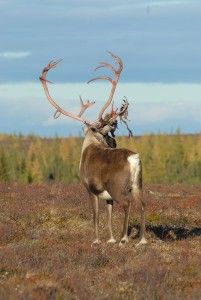by Ian Thorleifson
Caribou antlers are spectacular to look at, but the strategies behind their growth and importance to an individual caribou are even more amazing. Everyone knows that males like to show off for females – that goes without saying. Caribou bulls are no different than males from other species, and the females do respond appropriately, but the showing off and responding is much more complex than just a look.
A caribou bull weighs about 325 pounds or 160 kg. They start with a bare forehead every spring, and in less than 120 days they grow a complete set of antlers that may weigh as much as 35 pounds – 10 percent of their body weight! That kind of growth is almost magical – in fact, no other living tissue grows that quickly except mushrooms!
While the antlers are growing, they are soft, covered with skin and hair and made up of spongy cartilage. They feel like your nose and similarly also have a bone at the base. Unlike your nose however, in the last month of antler growth the cartilage calcifies and becomes hard bone.
To keep the antlers tough and resilient enough to withstand the incredible pressures of battling with other bulls, the blood flow in the antlers – super quick and of large volume while the antlers are growing – slows to just the bare minimum. This prevents the bone from becoming too hard, as to be brittle and easy to break.
Growing new appendages that weigh 10 percent of body weight in such a short period of time takes more energy and nutrients than a bull caribou can generate by eating, so he robs his own skeleton for building materials like calcium and phosphorus, to the point where his ribs would break easily if they were struck in the summer. This is why the bulls complete their antler growth at least a month before the rut. They need to gobble as much nutrition as possible to replace those borrowed building materials and get strong and fat before the rut.
Antlers are expensive, but they add up to a graphic demonstration of the bull’s health, ability to mobilize nutrients and avoid predation – a measure of his vibrancy and value as a sire of many caribou calves.
Caribou cows grow antlers as well, but their strategies are quite different. Their antlers are much smaller than the ones the bulls grow, and they don’t need them to “show off” with – they need them to fight with at feeding sites and to fend off predators.
Bulls grow their antlers earlier in the year, use them in the rut, and drop them as soon as the rut is over. Cows grow their antlers later, and carry them all winter. Amazingly, cows that are not pregnant going into the winter drop their antlers earlier as well, so by late spring and calving time, all the antler advantage in competition for nutrients or fighting wolves goes to the pregnant cows. Shortly after the calves are born in early June, newly growing plants offer a flood of nutrients. The cows drop their remaining antlers and…
nature’s elegant cycle begins anew.









